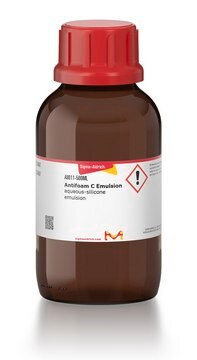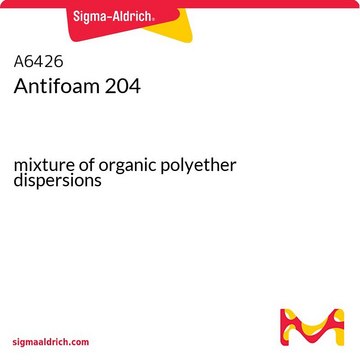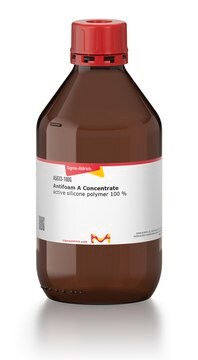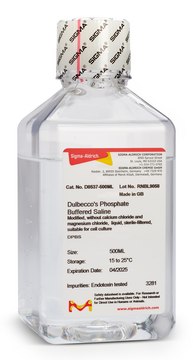A5757
Antifoam B Emulsion
aqueous-silicone emulsion
Sinônimo(s):
Antifoaming agent B
Faça loginpara ver os preços organizacionais e de contrato
About This Item
Código UNSPSC:
12161900
NACRES:
NA.25
Produtos recomendados
Formulário
emulsion
contém
emulsifier (different from those present in Antifoam A emulsion)
técnica(s)
cell culture | hybridoma: suitable
microbiological culture: suitable
Descrição geral
Antifoam eliminates excessive foaming formed during impingement, due to proteins and/or carbohydrates in the collection medium. Antifoam B emulsion is a silicone based antifoam. Antifoam B emulsion does not affect the growth of bacteria. Antifoam B emulsion functions as an antifoaming agent in shake flask culture of bacteria.
Aplicação
Antifoam B emulsion has been used:
- to enhance collection efficiency in collection media
- as a component in stress granule lysis buffer to reduce foaming, in host cell lysis buffer to reduce foaming caused by detergents
- to improve solubility of antibiotics
- as a foaming controls in bacterial growth media
Outras notas
A 10% aqueous emulsion of polydimethylsiloxane
Código de classe de armazenamento
10 - Combustible liquids
Classe de risco de água (WGK)
WGK 3
Ponto de fulgor (°F)
>214.0 °F - closed cup
Ponto de fulgor (°C)
> 101.1 °C - closed cup
Escolha uma das versões mais recentes:
Já possui este produto?
Encontre a documentação dos produtos que você adquiriu recentemente na biblioteca de documentos.
Os clientes também visualizaram
Isolation of yeast and mammalian stress granule cores
Wheeler JR, et al.
Methods, 126, 12-17 (2017)
Celeste J Brown et al.
PloS one, 8(3), e60401-e60401 (2013-03-28)
Observing organisms that evolve in response to strong selection over very short time scales allows the determination of the molecular mechanisms underlying adaptation. Although dissecting these molecular mechanisms is expensive and time-consuming, general patterns can be detected from repeated experiments
Separation of metabolic supply and demand: aerobic glycolysis as a normal physiological response to fluctuating energetic demands in the membrane
Epstein T, et al.
Cancer & Metabolism, 2(1), 7-7 (2014)
High-Throughput Quantification of Bacterial-Cell Interactions Using Virtual Colony Counts
Hoffmann S, et al.
Frontiers in Cellular and Infection Microbiology, 8, 43-43 (2018)
Fermentation pH modulates the size distributions and functional properties of Gluconobacter albidus TMW 2.1191 levan
Ua-Arak T, et al.
Frontiers in Microbiology, 8, 807-807 (2017)
Nossa equipe de cientistas tem experiência em todas as áreas de pesquisa, incluindo Life Sciences, ciência de materiais, síntese química, cromatografia, química analítica e muitas outras.
Entre em contato com a assistência técnica









